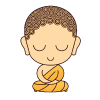Wat Phrapathomjaydee
Blessing amulets
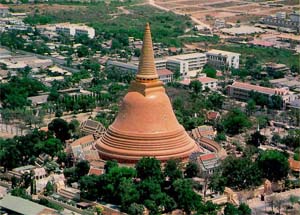
In BudBuddhism took root in Siam long before the present day Siamese migrated into the country, as is evidenced by the many ancient Buddhist stupas in different parts. Of the latter we may reckon Phra Pathom Jaydee to be the oldest. In actual fact, the well-known Chedi that we see nowadays is not the original one, which is inside having been built over by the newer structure. The stupendous bulk of the new conceals the ancient edifice.
-
The period of Suvarnabhumi (approx.193 B.C. 457 A.D.) when the sanctuary was first erected.
-
The period of Dvaravati (approx. 457-1057 A.D.) when the sanctuary was enlarged.
-
The period of decay (1057-1853 A.D.)
-
The period of restroration (from 1853 A.D. to the persent time).
Most of the earliest part of this history is, however, based on conjecture. So I have to apologize if my theories are incorrect.
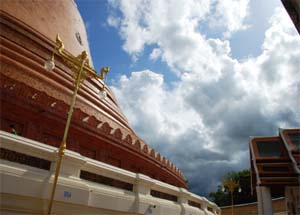
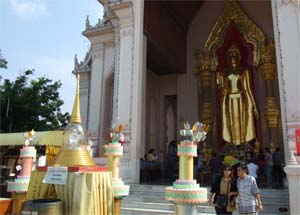
In order to realise when and by whom Phra Pathom Chdi was built, we must go back to the first diffusion of Buddhism from India. When Buddha died, his creed had already spread all over the central India. But it was King Asoka who spread Buddhism beyond the confines of India. He sent missionaries to many lands. There is a passage in Mahavamsa (History of Ceylon) difining various countries to wihch Asoka had sent his mission, of which this is an extract: Sona Dhera and Uttara Dhera went to Suvarnaphumi.
Professor Rhys Davis and others have agreed that this land of Suvamabhumi was a kingdom stretching from the land of the Mons (Southern Burma) to Annam, and from Burma to the Malay Peninsula; but where its Capital was still provided scholars with a subject of contection. The majority, however, state that the site of Nakorn Pathom ought to be the Capital of this ancient kingdom, and the town was probably called Suvarnabhumi at that time. They also point out that Nakorn Pathom was then nearer the sea than it is now, thus rendering communications easy. Many relics have also been found there, especially those made after the style of Asoka which are rarely found in such number in other places, such as various stupas (including Phra Pathom Chedi), stone wheels of law, tablets bearing the Buddhist credo, carved altars (asana) and Buddha's footprints, all of which preceded the making of the first Buddha Images in 143 B.C.
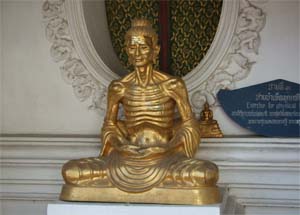
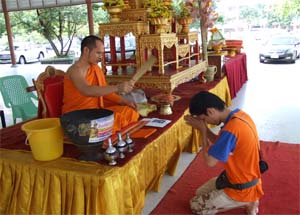
Phra Pathom Chedi is one of the most important evidences that Nakorn Pathom was the Capital city of Suvarnnabhumi. If we examine the original stupa inside the Chedi (there is a replica of it situated south of the Chedi). We shall see that it was restored serveral times until its shape was completely changed. If the prang (spire) is taken away, you wil see immediately that it resembles the great stupa as Sanchi which dates back to Asoka's times. Its shape is circular like an inverted basin or cup. On top is placed a square alter crowned with a chatra (parasol). The base is also square, have circumambient gallery and enclosure outside.
The fact that it is called Phra Pathom Chedi (The first Chedi) is also an evidence. King Mongkut (RamaIV) surmised that it probable was the first stupa to be built in this land after King Asoka had distributed Buddha's relics among various Buddhist counties. It was a big stupa, bigger than others to be found in Chiengmai, Chiengsaen, Nakorn Sridhumaraj, Laos or Cambodia.
We do not yet know precisely who built Phra Pathom Chedi; but whoever was able to erect such a tremendous stupa (the height of the original stupa being 39 metres) must have been the ruler of the land and he must have had it constructed in his Capital. Phra Pathom Chedi was most likely erected in third or fourth century of the Buddhist Era. That must have been the time when most of the people of Suvarnabhumi (not Siamese but Lawas or Mons) already professed Buddhism. When the stupa was completed, the environs became a temple, and Buddha relics given by Asoka might have been placed in it.
Itinerant monks also took up residence there during the rainy season; we have found traces of their habitation nearby, Phra Pathom Chedi ought therefore to be reckoned as a great sanctuary where Buddhism first take root in this country and whence it spread to neighbouring countries.
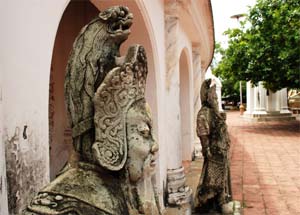
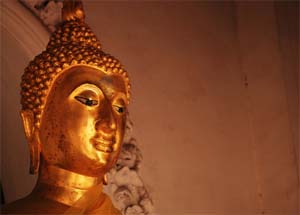
About the year A.D. 607, it was recorded by the Chinese scholars Hiuan-tsang and Yi-tsing that there existed a kingdom called Dvaravati (To-lo-po-ti), between Srikasetra (Burma) and Isanaburi (cambudia). This area corresponds to the land of Suvarnabhumi that we have been speaking of. Many Buddha Images of the Indian Gupta style (A.D. 320-499) as well as stone pillars with inscription in ancient Mon Characters and carved stone tablets, were also found at Nakorn Pathom. There are all considered to date back to that period.
Luang Boribal Buribandh, Curator of the National Museum in Bangkok, has explained that Suvarnabhumi and Dvaravati are the same place, differing only in name; the Indians called it Suvarnabhui and the Chinese called it Dvaravati. He says: "The antiquites of Nakorn Pathom can be classified from the period of Suvarnabhumi down to Dvaravati. European books always that Dvaravati came into being when the kingdom of Funon lost its power.
This implies that Dvaravati was set up after Funan (A.D.217-550). This statement, if applied only to the name Dvaravati, is permissible, but it must be erroneous if applied to the name Nakorn Pathom. At Nakorn Pathom, there are antiquities dating back beyond the time of Funan, such as the relics made after Asoka's style,Buddha Images and votive tales made after the style of AMaravadi (A.D.120-182)." Thus we many conclude that Nakorn Pathom was the Capital of both Suvarnabhumi and Dvaravati.
The fact that this stupa was restored several times is also evident. The Chronicle of Phya Maha Akanikorn and Nai Tong states that Phya Bali Badichai, who ruled over Nakorn Luang near Yasothorn, and Phya Sai Tong Som, ruler of Nakorn Chaisri (Nakorn Pathom) or according to others Rajburi, together killed their father Phya Balidhiraj and seduced their mother
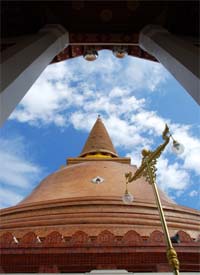
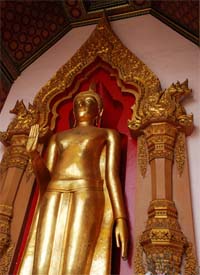
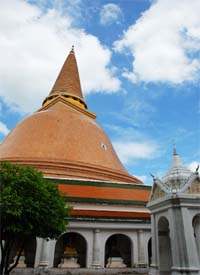
Afterwards, both were stricken by remorse and decided to atone for their sins by restoring Wat Phya Sanga Ratanadhatu and Phra Aram Ban Dharmasala which Phy Sri Sidhichai had previously erected another chronicle, that of Phya Raj Sambharakorn and To Pa Kaw Rot, say that Phya Pan, killing his father Phya Kong and his nurse Yai Hom, was also overcome with remorse and consulted the Buddhist clergy, who advised him to build a stupa of a height equal to that of a turtle doves flight. Phya Pan thereupon created Phra Pathom Chedi. These two lengends are the same.
They show that the stupa was restored in the later period, as we can see from the prang of the original stupa. The prang itself was restored, because if it had been built by Phya Pan it would have been of the Mon style, as Phya Kong and Phya Pan were Mons. On the countrary, the prang is in the Cambodian style, (The Cambodians might have repaired it when they were the overlords of this land from A.D. 957 onwards).
Now for the period of decay of Phra Pathom Chedi. It is recorded in Burmes history that in A.D.1057 King Anuratha(anawrahta mangchaw) of burma, who ruled over pagan, came with this army to attact the town of thaton (in the land of the mons) where people professed buddhism and had built many beautiful stupas and temples. King anurutha took away as captives all the inhabitants of Thaton, and the town was left deserted. This statement, however, was not assented to be many scholars, such as Sir George Scott, who maintained that the Thaton there were no indications of any ancient stupas and temples as recorded. He thought that King and Anurutha might have taken his models from Angkor Wat in Cambodia. It was surmised by H.R.R.Prince Damrong Rajanubharb that King Anurutha really attacked the town of Nakorn Pathom, where ther are still visible traces of and abundance of ancient stupas and temples which date back to a period before that of King Anurutha. Other evidences are the Budhist votive tablets and some ancient silver coins bearing a conch on one side and pavillion on the other which were dug up at Nakorn Pathom, the like of which have not been found anywhere else in our part of the world except at pagan.
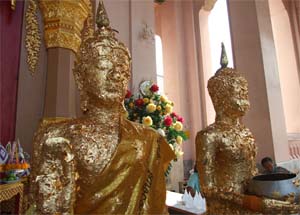
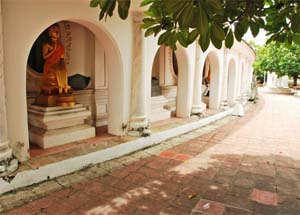
Another important evidence is that the Ananda temple at Pagan which was biult by the King who succeeded the successor of King anurutha, was designed in the same way as Wat Phra Meru at Nakorn Pathom, differing only in the attitude of the four Buddha Images in the four nichces: at Wat Phra Meru they are siting Buddhas with feet hanging down, whereas at the ananda temple, they are standing Buddhas. In the legend of Phya Raj Sambharakorn and Ta Pa Kaw Rot, it is stated that the King of Pegu, who was very powerful, wanted to have a gong the sound or which could heard of the whole day and which was placed at the base of Phra Bantom (Phra Pathom Chedi), which Phya Pan had erected. He raised an army and came consulting his officials, decided to build a prang on top of the collapsed stupa. Colonel Gerini said that the name of this King of Pegu was Bhanuraj and the period of his reign might have been between A.D.1017-1195.
If we consider the story of King ANurutha is conquest of Thaton in A.D.1057, which also includes the statement that he tried to dig up the Buddha relics in the stupa at Thaton and the sacred relics fell deep in to the earth, we shall see that the names, stories and dates are very similar. Luang Boriban has further surmised that after the fall of Nakorn Pathom, the inhabitans might have migrated to the town of Utong, especially as Dr.Quarritch Wales has stated that Utong was the last Capital of Dvaravati in the stone inscription of King Ramkamheang. A.D.1292, there is the name of the town of Supanbhumi (Suvarnbhumi), which Prince Damrong has identified as Utong.
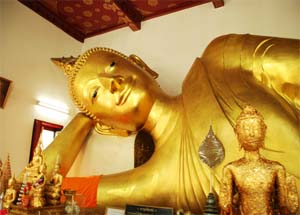
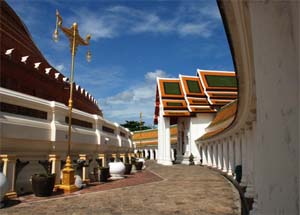
If the statement of Prince Damrong concerning the ancestors of King Utong is correct, about a hundred years afterwards, circa A.D.1188, King Jaya Ciri, the ancestors of King Utong founded of Ayutaya, after being vanquishad by the Mons, returned to settle down in this town again. The town of Nakorn Pathom was abandoned for a second time, however, because of the increasing shallowness of the river. It was re-established in the reign of King Maha Chakrabati, circa A.D.1548 and known by the name of Nakorn Chaisri. His was in preparation for a Burmese invasion; but the town was some distance form Phra Pathom Chedi. It was situated on the bank of the Tachin River, at the site of the present Thana distric of Amphoe Nakorn Chaisri. Phra Pathom Chedi was left to decay in the jungle without care or attention, althought monks came to reside there during the reign of King Rama II (A.D.1809-1842). In the reign of King Rama III (A.D.1834-1851), his brother prince (Later King) Mongkut, while a member of the Buddhist priesthood, went several times on prilgrimage to the stupa. As he considered it a sanctuary worthy of restoration, he approached his royal brother, who however held a different opinion. On his accession to the throne, King Mongkut ordered Somdej Chao Phya Borom Maha Phrayuravongsa to restore the stupa. This was done in A.D.1853 by building an enormous Chedi to cover that original one. This nobleman unfortunately died before his pious task was completed. It was continued by his son, Chao Phya Dipakaravongsa(Kam), but the Chedi had to be entirely rebuilt because the one erected by his father collapsed after a heavy downpour of rain. King Mongkut then ordered H.R.H.Prince pavares Variyalongkorn and H.R.H.Prince Rajasiha vikron to design the plan.
Wihle still Crown Prince, King Rama VI found the quiet surroundings of this suburb of Nakorn Pathom a pleasant chang from the noise and bustle of the city. It moreover appealed to the young Prince because of its having underneath the surface some vestiges of ruins. All around Nakorn Pathom, infact, are such possibilities of archaeological finds.
To the east there are monument of Phra Pathom and the monastery of Dharmasala; to the southwest are teh moneyment of Wat Phra Meru and further away the Wat Don Yai Hom; to the north the old camp of Kampang-sean and to the east imediately past the railway godowns is the earth mound underneath which there must be some archaeological monument, perhaps a cetiya, or Chedi, but now built over by the people as a wat named the Wat Phra Ngam. And then there is Sanamchandra.
The ruins and monyments are very old; oso old that the local intabitants can only tell us of myths about them. The story goes that once upon a time Phya Kong ruled over this district. He had a son, who, astrologers perdicted, would one day kill his father. The son was therefore left to die but was taken away and secretly brought up by an old woman, Yai Hom, out of pity.
The boy grew into a hero and was known as "Pan". Without knowning that the ruler was his own father he opposed him as the people's oppressor, and engaging him in single combat where Wat Dharmasala now stands, kiled him and became King with the style of Phya Pan. Then finding out that the oppressor whom he had killed was really his father, he put the whole blame upon the old woman Hom and put her death. He then became obsessed by remorse and worry arising from the fact of his double act of ingratitude; he consulted monks as to how to atone for his sins. The answer was that he should build a Chedi "as high as the wide pigeon flied." Hence the great monument of the Chedi of Phra Pathom.
Text by M.C. Subhadradis Diskul


